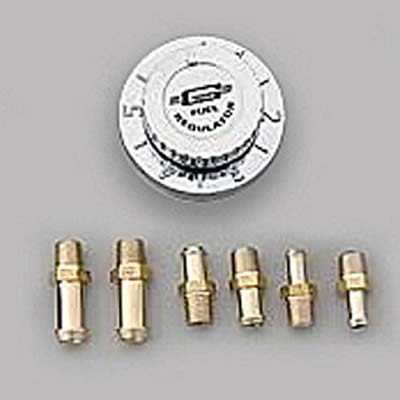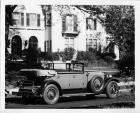|
Re: Proper psi at carburator
|
||||
|---|---|---|---|---|
|
Home away from home

|
From post #1 above:
"however the carb still runs out of fuel when I go uphill or faster than about thirty mph or so..." THis is a symptom of an ethanol swollen needle valve. The needle valve is most likely "rubber" tipped. Wrong compunding of the rubber for ethanol compatability. Replace with a SOLID tipped needle. DO not trust ANY "rubber" tipped needle. When the 'rubber' tipped needle swells it causes the float level to drop dramatically causing a high speed lean condition.
Posted on: 2011/5/4 7:00
|
|||
|
VAPOR LOCK demystified: See paragraph SEVEN of PMCC documentaion as listed in post #11 of the following thread:f
packardinfo.com/xoops/html/modules/newbb/viewtopic.php?topic_id=7245 |
||||
|
||||
|
Re: Proper psi at carburator
|
||||
|---|---|---|---|---|
|
Home away from home

|
PackardV8, I'll certainly check that when I pull the top! Great info! Also, Cort, that is exactly the same thing that I have right now. It's the only one that the parts store I went to had. Damn! Well, at least now I know for sure that this thing is a piece of junk! Thanks again all,
Scott
Posted on: 2011/5/4 8:58
|
|||
|
||||
|
Re: Proper psi at carburator
|
||||
|---|---|---|---|---|
|
Home away from home

|
NOTE: that there are "modern" rubber tipped needles that are compatiable with MODERN gasoline. BUT NEXT YEAR, depending on sporadic and unpredictible standards in the modern world, the gasoline mite contain some other additive that renders TODAYS rubber tipped needles NONcompatable.
That is why i recommend the SOLID needles.
Posted on: 2011/5/4 9:07
|
|||
|
VAPOR LOCK demystified: See paragraph SEVEN of PMCC documentaion as listed in post #11 of the following thread:f
packardinfo.com/xoops/html/modules/newbb/viewtopic.php?topic_id=7245 |
||||
|
||||
|
Re: Proper psi at carburator
|
||||
|---|---|---|---|---|
|
Home away from home
|
This is a subject I have had lots of (bad) experience with.
These cheap chrome regulators were put on 3 of my cars and I had fuel feed problems with all three of them. When I took them off the cars ran fine. I am using an adjustable pressure regulator on my vintage race car, but it costs 3 times what the cheap junk ones cost. The expensive one works. The electric pump may be the wrong one. I had a "professional" put a rotary electric pump on my motor home that was suffering from vapor lock. Later when a real professional took a look at the vehicle he found it was a high pressure boost pump made for modern fuel injected cars and was delivering way too much pressure. You might check the electric pump with a fuel pressure gage on the outlet I also have experienced the fuel blockage on a rubber hose that replaced the factory flex hose. The hose was bent to a tight radius which eventually became a restriction. The factory flex hose is better reinforced with a braid and will not collapse as easily as a rubber fuel hose. I have also experienced problems with a fuel tank that was cleaned out and sealed with some high priced "goop". The sealant plugged up the factory filter on the inlet to the fuel line inside the tank. No fuel would come out of the tank and there was no way to fix the totally sealed up filter. I had to toss the tank and start over. This was not a Packard so I am not sure if that could be a problem on your car. A fuel pressure gage at the inlet to the carburetor will help you sort out these fuel feed problems.
Posted on: 2011/5/4 9:37
|
|||
|
Fred Puhn

|
||||
|
||||
|
Re: Proper psi at carburator
|
||||
|---|---|---|---|---|
|
Home away from home

|
THe only thing a fuel pressure regulator (assuming carburetor) is good for is to optimize gas mileage relative to performance demand. A regulator will NOT increase the maximum output of the pump.
Posted on: 2011/5/4 9:59
|
|||
|
VAPOR LOCK demystified: See paragraph SEVEN of PMCC documentaion as listed in post #11 of the following thread:f
packardinfo.com/xoops/html/modules/newbb/viewtopic.php?topic_id=7245 |
||||
|
||||
|
Re: Proper psi at carburator
|
||||
|---|---|---|---|---|
|
Home away from home

|
A fuel pressure GAUGE at the pressure side of the pump is a good idea.
But how come noone ever thinks to add a gauge at the SUCTION side of the pump????? One gauge reading with out the other is about as useless as no gauge at all. THere has been alot of theoretically correct belief that vapour lock occurs on the suction side of the pump. I doubt it. Without a gauge at BOTH suction and pressure side of pump (assuming oem pump location) then the data is nearly worthless and so is the theory of vapor lock at the suction side.
Posted on: 2011/5/4 10:16
|
|||
|
VAPOR LOCK demystified: See paragraph SEVEN of PMCC documentaion as listed in post #11 of the following thread:f
packardinfo.com/xoops/html/modules/newbb/viewtopic.php?topic_id=7245 |
||||
|
||||
|
Re: Proper psi at carburator
|
||||
|---|---|---|---|---|
|
Forum Ambassador
|
I have also experienced problems with a fuel tank that was cleaned out and sealed with some high priced "goop". The sealant plugged up the factory filter on the inlet to the fuel line inside the tank. No fuel would come out of the tank and there was no way to fix the totally sealed up filter. I had to toss the tank and start over.
This is a very valid point. Possibly not for this problem--although you did mention tank was sealed--but for others who do the shake, rattle and reseal method of tank cleaning. There is no filter on a Packard tank but this same problem can happen. The fuel pickup is just the end of the fuel line pointing down into a depression in the bottom of the tank. Open end is probably about 1/8-3/16 above the bottom. If the goop is applied and tank lays flat or at a low angle while it dries, if there is an excess of sealant it can run down into the depression and block things quite well. Believe Keegan posted a picture of a cut open tank and pickup a few months ago.
Posted on: 2011/5/4 10:26
|
|||
|
Howard
|
||||
|
||||
|
Re: Proper psi at carburator
|
||||
|---|---|---|---|---|
|
Home away from home
|
I never added a gauge to the suction side because i had fuel there, and it didn't help my troubleshooting process. I wasn't considering its use for vapor lock as much as a little bit of info as to what was going on right before the carb for troubleshooting later if i did something wrong.
I know a regulator can't increase fuel pressure, but rather restrict it. I was having a sort of flooding issue at the time and i thought that the fuel pump was overpowering the needle and seat in spurts as it pumped. I wanted a regulator to back it off to about 3 psi to see what would happen. I've had some others warn me about that cheap regulator after i had bought it also. Maybe it's just a bad design. However, even if you had no fuel coming in on the suction side due to vapor lock or out of gas or what have you, the car is usually sitting with 3-4 psi of fuel pressure when off. If you went to start the car and pumped the pedal once or twice, the pressure in the line would top off the bowl. Even if you were out of gas or the suction line disconnected, the car should still start. Just for a moment or two until you're out of gas in the bowl. With a clear suction line, i didn't see any need to put a gauge there.
Posted on: 2011/5/4 10:30
|
|||
|
||||
|
Re: Proper psi at carburator
|
||||
|---|---|---|---|---|
|
Home away from home

|
A pressure gauge on the suction side of the pump?? There is no pressure on the suction side to measure, there's suction or in other words a slight negative pressure.
Get a factory service manual or a Motors Manual and follow the professionally written and time tested diagnostic procedures. The output pressure of a mechanical fuel pump is determined by the diaphragm spring. The cars ran when they left the factory and then for thousands of trouble free miles. Cars are logical animals, treat them as such
Posted on: 2011/5/4 22:02
|
|||
|
||||

 (11.98 KB)
(11.98 KB)







